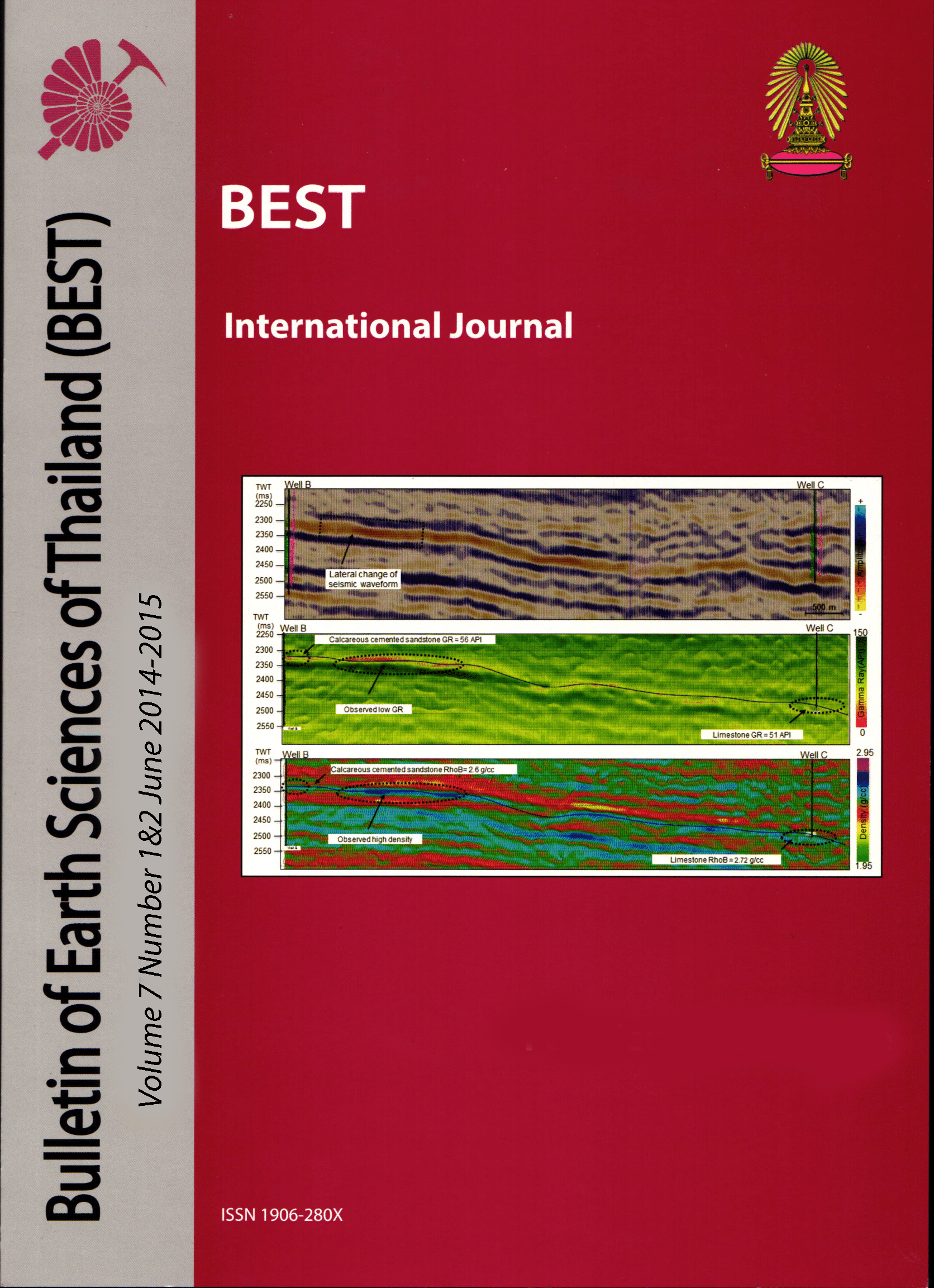ANALYSIS OF FLUVIAL SYSTEM PARAMETERS IN THE PATTANI BASIN, GULF OF THAILAND
Main Article Content
Abstract
The purpose of this study is to predict reservoir geometries , to study of the relationship of fluvial channel parameters and to optimize drilling locations within the Miocene fluvial systems which are the main productive oil and gas reservoirs in the Gulf of Thailand. However, it hard to predict reservoir geometries in the Miocene section due to poor seismic resolution whereas the Pleistocene to Recent seismic section has excellent resolution properties. For this reason this study measures the extensive channel parameters in the shallow section to be used as analogues for the deeper targets. 3D seismic plan view images of horizon slices as well as satellite images of modern fluvial systems were interpreted and channel parameters from 42 channels were used to study the relationship between fluvial channel wavelength, channel width and channel sinuosity. The modern fluvial systems included the Chao Phraya and Ping rivers. The shallow 3D seismic from 90 ms to 300 ms TWT showed channels and point bars which were clearly imaged. The deeper 3D seismic data which was used to incorporate shallow well log data in order to correlate point bar thickness was less reliable for its seismic resolution . Previous studies have suggested that there is a good relationship between key fluvial parameters such as channel wavelength, width and point bar thickness but this study came up with less conclusive results. The results found that there is a wide range in channel parameters even within similar systems. Fluvial geometries are controlled by many factors and it is difficult to develop any fixed relationships between the various parameters. However, channel width versus wavelength does show a link although the correlation coefficient is quite low. The lack of determining any clear relationships between the fluvial parameters is in part due to poor measurement capabilities, particularly in the deeper seismic data set.
Article Details

This work is licensed under a Creative Commons Attribution-NonCommercial-NoDerivatives 4.0 International License.
Copyright © 2008 Department of Geology, Faculty of Science, Chulalongkorn University. Parts of an article can be photocopied or reproduced without prior written permission from the author(s), but due acknowledgments should be stated or cited accordingly.
References
Brice, J. C., 1975, Airphoto Interpretation of the Form and Behavior of Alluvial Rivers, WASHINGTON UNIV ST LOUIS MO.
Feng, Z. Q., 2000, An investigation of fluvial geomorphology in the Quaternary of the Gulf of Thailand, with implications for river classification, Doctoral dissertation, University of Reading, 199 p.
Gibling, M. R., 2006, Width and thickness of fluvial channel bodies and valley fills in the Geological record: a literature compilation and classification. Journal of sedimentary Research, v. 76, no.5, p. 731-770.
Guo, H., & Deutsch, C. V. (2010). Fluvial channel size determination with indicator variograms. Petroleum Geoscience, v. 16, no. 2, p. 161-169.
Knighton, D., 1998, Fluvial forms and processes, A new perspective: London, Edward Arnold, p. 383.
Labrecque, P. A., S. M. Hubbard., J. L. Jensen., and H. Nielsen, 2011, Sedimentology and stratigraphic architecture of a point bar deposit, Lower Cretaceous McMurray Formation, Alberta: Canada. Bulletin of Canadian Petroleum Geology, v. 59, no. 2, p. 147-171.
Leopold, L.B., M.G. Wolman, and J.P. Miller, 1964, Fluvial Processes in Geomorphology. Freeman, San Francisco, 522pp.
Posamentier, H. W., A. Madrof., H. Reijenstein., S. Lang, J. Logan, and K. Purdy, 2014, Fluvial systems in the Gulf of Thailand –Stratigraphic Implications for Exploration and Development, in 2014 Annual Convention and Exhibition, Houston (Abstract).
Reijenstein, H M., H. W. Posamentier, and J P. Bhattacharya, 2011, Seismic geomorphology and highresolution seismic stratigraphy of inner-shelf fluvial, estuarine, deltaic, and marine sequences, Gulf of Thailand: AAPG bulletin, v. 95, no.11, p. 1959-1990.
Rosgen, D. L., and H. L. Silvey, 1996, Applied river morphology Pagosa Springs, Colorado:Wildland Hydrology, v. 1481.
Samorn, H., and O. Chevron, 2006, Fluvial Reservoir Architecture from Near-Surface 3D Seismic Data, Block B8/32, Gulf of Thailand, Doctoral dissertation, Colorado School of Mines, 156 p.
The United States Department of Agriculture., 2007, Channel Alignment and Variability Design, Part 654 Stream Restoration Design National Engineering Handbook, Washington, DC. P. 1-17.
Thorne, C. R., R. D. Hey, and M. D. Newson, 1997, Applied fluvial geomorphology for river engineering and management, John Wiley & Sons Ltd.
Yalin, M.S.,1992, Mechanics of Sediment Transport, 3rd Edition, Pergammon Press, New York, NY.


